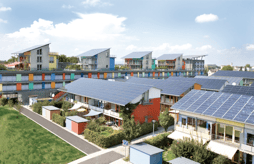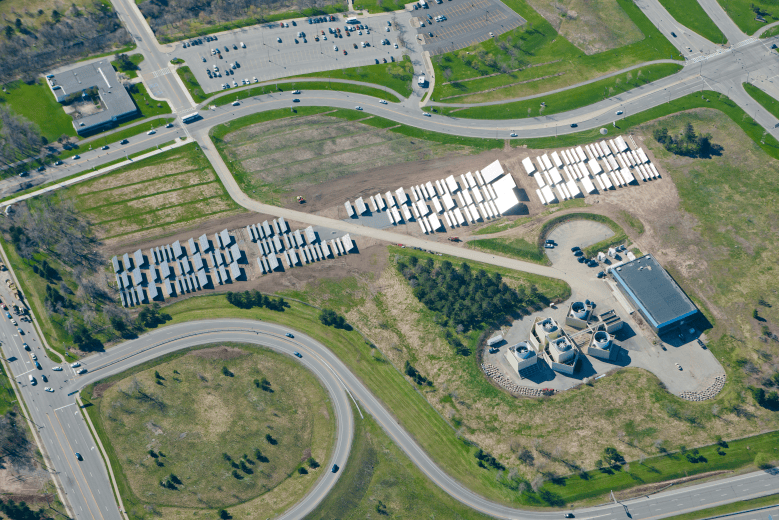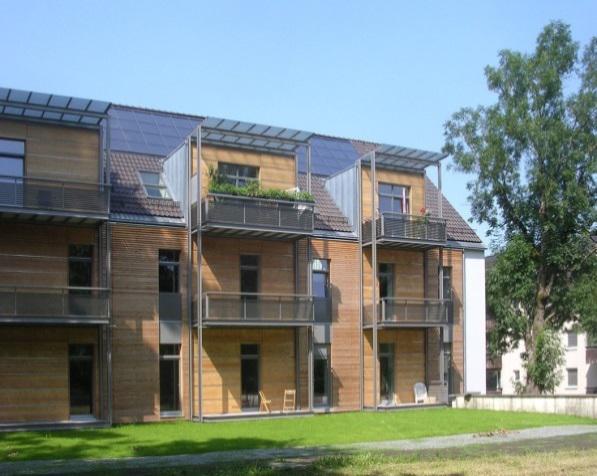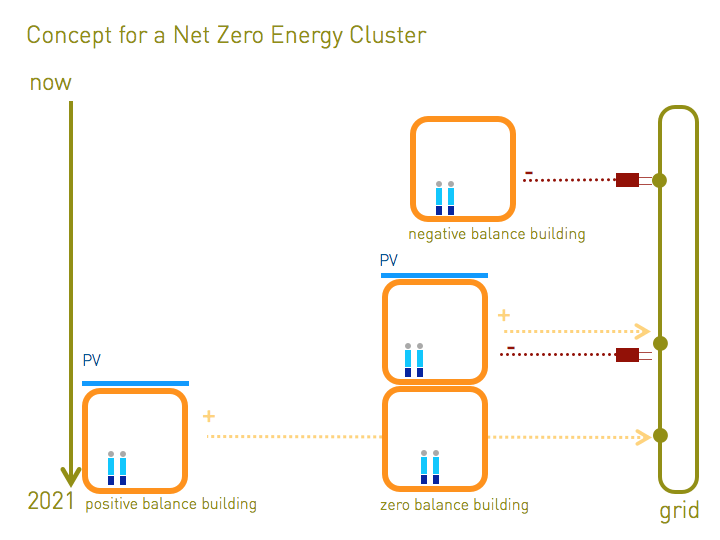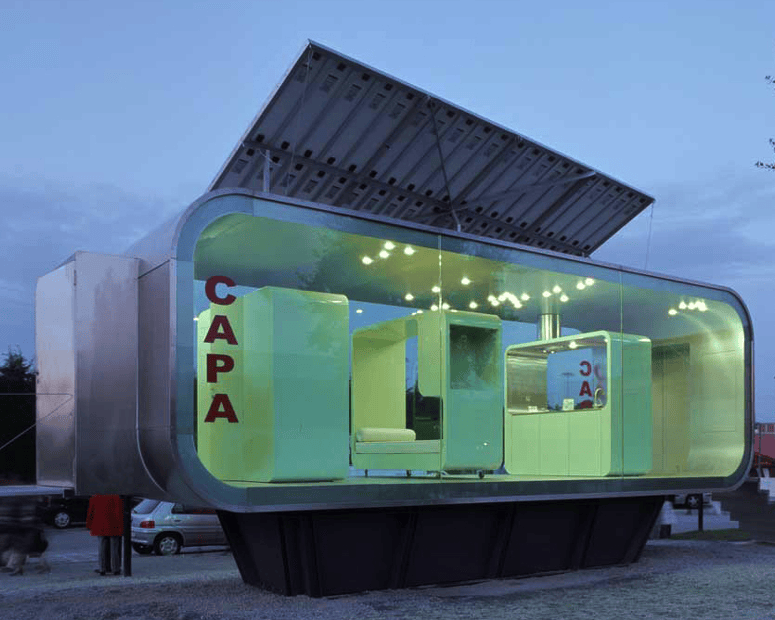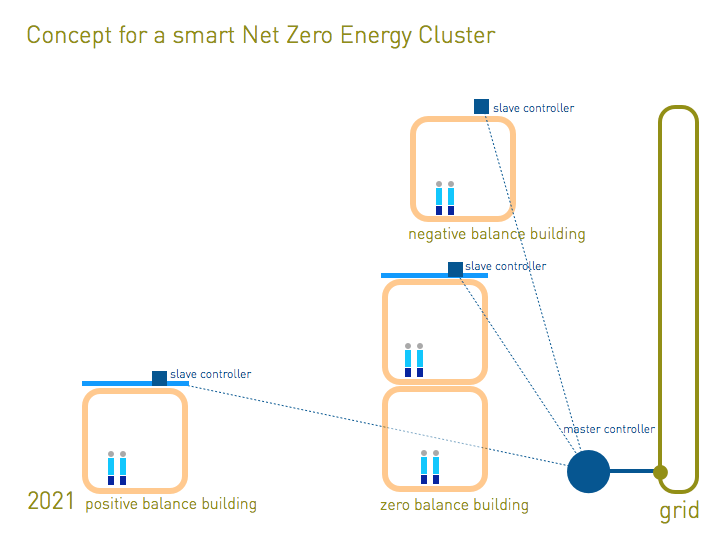Photovoltaics and Net Zero Energy Buildings: new concepts towards a smart city vision
Alessandra Scognamiglio, Giovanna Adinolfi, Giorgio Graditi - ENEA, Technical Unit for Technologies Development - Portici Research Centre
Rossana Paparella, Erika Saretta - DICEA, University of Padova, Faculty of Engineering
DOI: 10.12910/EAI2013-34
The wide use of renewables has changed the energy scenario in recent years, and the European Directive 2010/31/EU on Nearly Zero Energy Buildings (NZEBs) is going to be the driver of an even more radical shift. The building is going to be transformed into an energy generation system, and its design should consider not only the traditional design aspects, but the energy aspect, too. In particular, in the present paper two main issues will be addressed: the design of NZEBs with a special focus on PV and the broad concept of “smartness” with a focus on the role of the PV technology. Finally, some new research issues will be proposed as new topics to be investigated towards a smart city vision.
The wide use of renewables has changed the energy scenario in recent years, and the European Directive 2010/31/EU on Nearly Zero Energy Buildings is going to be the driver of an even more radical shift. According to this Directive, a Nearly Zero Energy building is a high performance building, that generates the energy it needs by using renewables on site or nearby [1]. From this perspective, the building is going to be transformed into an energy generation system, and its design should consider not only the traditional design aspects, but the energy aspect, too. This means designing the devices able to generate the energy the building needs for functioning, together with the building itself.
One consequence of these likely changes is that the conventional, centralised energy system is going to be replaced by a "web" of energy systems. Such a web corresponds, in a way, to the pattern of the city itself (the buildings being the future energy generating systems themselves). This new condition requires further investigation at least on two aspects: the energy web has to be properly managed so as to ensure a good performance of the energy grid, and significant energy savings; designing the physical form of the city shall consider the use of renewables in its domain.
What is the role of Photovoltaics (PV), what are the new research needs we should face in the next years?
This paper tries to give some first possible answers to these questions.
In particular, firstly some issues related to the design of Nearly (or Net) Zero Energy Buildings will be addressed, with a special focus on PV. Secondly, the broad concept of “smartness” is addressed with a focus on the role of the PV technology. Finally, some new research issues will be proposed as new topics to be investigated towards a smart city vision.
Photovoltaics and Net Zero Energy Buildings: towards a smart vision
Building Integration of Photovoltaics
A Building Integrated Photovoltaic system (BIPV) is a system where photovoltaic modules are arranged into a technological envelope sub-system and can replace the traditional elements of the building envelope. These systems are generally mentioned as “BIPV”. If the modules do not replace envelope components, but they are only “added” on the envelope, the systems can be defined as “Building Attached” or “Building Added”, and mentioned as “BAPV”.
This distinction, commonly shared in the international PV scientific community, was also proposed by the Italian feed-in tariff, since the third edition of the so called “Conto Energia”, which assigns the highest tariff to systems where special innovative PV components suitable for building integration are used.
Therefore, when the solar system is integrated in the building envelope (as roof covering, façade cladding, sun shading, balcony fence...), it must properly take over the functions and associated constraints of the envelope elements it is replacing (constructive/functional quality), while preserving the global design quality of the building (formal quality).
ENEA has been participating in the work of the International Energy Agency (IEA), Solar Heating and Cooling (SHC) Task 41 “Solar Energy and Architecture” (May 2009-April 2012), that aimed to improve the awareness of the designers in using solar components conceived as building elements, so as to focus on the energy performance and on the architectural quality, too. Some of the following considerations come from the results of the work carried out in the framework of Task 41 [2] .
In the following, some functional and constructive aspects of the integration of PV in buildings are presented.
The building envelope has to fulfil a wide and complex set of protection and regulation functions, requiring the use of different structures and components (opaque/semi-transparent elements, monolithic/multilayer structures, composed of fixed/mobile parts,...). The integration of solar modules in the envelope system should then be studied very carefully, to preserve/ensure the standard envelope functions and the durability of the whole.
The multifunctional use of solar elements taking over one or more envelope functions may require an extra effort to building designers, calling, for instance, for some modifications in the original design of the collector, in the way it is mounted or by restraining its use in some parts of the building. On the other hand, it brings the major advantages of a global cost reduction and an enhanced architectural quality of the integration.
In addition to the functional compatibility, it is important to ensure that the new multifunctional envelope system meets all building construction standards:
- the collector load should be correctly transferred to the load-bearing structure through appropriate fixing;
- the collector should withstand fire and weather wear and tear;
- the system should resist wind load and impact, and should be safe in case of damage;
- risks of theft and/or damage related to vandalism should be evaluated and appropriate measures taken;
- the fixing should avoid thermal bridges and the global U value of the wall should not be negatively affected;
- vapor transfer through the wall should avoid condensation layers, and allow the wall to dry correctly.
Besides these standard building construction constraints, the integration of solar systems implies other issues resulting from specific solar technology attributes, i.e. electric cabling and the high temperatures of some modules:
- the electric cabling of PV should be studied to avoid shock hazards and short circuits, and measures should be taken to avoid fire;
- envelope materials in contact with the solar modules should withstand their high working temperature;
- fixing details and jointing should make the expansions of the collector materials compatible with those of the other envelope materials;
- safety issues should be considered for collectors within users' reach to avoid burning or shock hazards (ground floor, window and balcony surrounding ...).
As seen, integrating the new function "solar collection" into the building envelope requires an understanding of where (opaque parts, transparent parts, fixed/mobile elements), how, and which collectors can be made compatible with the other envelope elements, materials, and functions.
Each technology or sub-technology has different implementation possibilities in different parts of the envelope[3].
All the system characteristics affecting the building appearance (i.e. system formal characteristics) should be coherent with the overall building design:
- the position and dimension of collector field(s) have to be coherent with the architectural composition of the whole building (not just within the related façade);
- collector visible material(s) surface texture(s) and colour(s) should be compatible with the other building skin materials, colours and textures they are interacting with;
- module size and shape have to be compatible with the building composition grid and with the various dimensions of the other façade elements;
- jointing types must be carefully considered while choosing the product, as different jointing types underline the modular grid of the system differently in relation to the building.
Clearly, mastering all characteristics of an integrated PV system from both the perspectives of energy production and building design is not an easy task. The formal characteristics of the system are strongly dependent on the specific solar technology, which imposes the core components of the solar modules, with their specific shapes and materials.
The more flexibility can be offered within these imposed forms and materials, the more chances for a successful integration. The actual flexibility of solar modules (hereinafter referred to as “integrability”) is the guarantee for a satisfying integration of PV [4].
The Use of Photovoltaics in Net Zero Energy Buildings
The recast of the European Directive 2010/31/EU establishes that starting from the end of 2020 all new buildings will have to be Nearly Zero Energy Buildings (Nearly ZEBs).
As already said in the introduction, according to this Directive, Nearly Zero-Energy Building means a building that has a very low yearly energy consumption, which can be achieved by both highest energy efficiency and energy from renewable sources, which shall be on-site or nearby.
This definition is wide enough to leave room for many definitions of what a Nearly (or Net) Zero Energy Building is and the way it can be designed. On this topic, ENEA has been participating in the work of the International Energy Agency (IEA), Solar Heating and Cooling (SHC) and Energy in Buildings and Communities (EBC) Task 40-Annex 52 “Towards Net Zero Energy Solar Buildings” (October 2008-September 2013). Some of the following considerations come from the results of the work carried out in the framework of the Task 40-Annex 52[5].
Generally speaking, the term ZEB (Zero Energy Building) identifies a residential or commercial building that reduces its energy needs thanks to efficient energy gains and that supplies the resulting low energy demand through renewable energy sources, in order to reach a Zero Energy Balance between annual energy consumptions and energy supply.
Only by decreasing energy consumptions is a path towards a Zero Energy Balance possible and, moreover, without the grid it would be very difficult. Hence, the term “Net” is introduced in order to highlight on the connection between the building and the energy grid because, for the wide mass of ordinary buildings, the ZEB self-supplied by renewable cannot represent the model of the future.
In particular, the electric grid connection offers a significant advantage because of the possibility to exchange electricity. This solution allows to overcome the limits of the current generation of storage technologies that have no long term storage of energy in situ. As a consequence, the connection with the energy grid is allowed and necessary both for picking-up the energy and also to sent non-used energy.[6] This is the main reason why to consider the Net Zero Energy Buildings (NetZEBs).
The first step to achieve the NetZEB goal is the reduction of the energy demand by means of passive solutions and energy efficiency and, of course, using sustainable materials for its construction. The second step is represented by the generation of the energy required by users thanks to the renewable energy systems (RES).
In order to create a univocal and standardised calculating method of energy balancing, some criteria should be considered and chosen: Building system and balance boundary; Weighting system; Period and type of balance. [7]
The concept of “boundary” seems to be very relevant with regard to the use of energy systems.
The balance boundary defines both the physical boundary of the project which is part of the energy balance consideration (single building, cluster of buildings) and the generation sectors, that clarify which renewable energy options are considered and how.
A broad frame (e.g. cluster of buildings) implies a synergy between several buildings, which are not necessarily NetZEBs as singles but as a whole: buildings with a positive energy balance can compensate such ones with negative balances.
This approach is possible in the case of new buildings and district design (Figure 1), and is particularly suited for projects on existing buildings or districts (Figure 2). In particular, in the case of interventions on existing buildings in “dense” cities, where the surfaces for placing the energy generating systems are limited, very often a single building cannot reach the NetZEB balance on its own. Generally, the energy demand is high (obsolete envelopes or vertical buildings with high density of energy consumption), compared to the available surfaces for solar systems, and the effect of shadow limits the use of the envelope surfaces very much.
In relation to a NetZEB design, the possible renewable supply options are:
- in the building physical footprint (e.g. PV on a building roof);
- on-site renewables (e.g. PV on roofs of a parking lot or small-scale wind turbines);
and:
- nearby renewables (e.g. systems close by financed by the building owner or user, such as shared CHPP);
- off-site renewables for on-site use (e.g. biomass);
- purchased “green” energy from contracts, off-site wind turbines (electricity) or CHPPs (electricity, heat and cold).
The focus for the design of NetZEBs (to reduce the use of new land) should be conceiving the building along with its energy balance. It implies that the energy generation should be in the building property, which means any arrays that could be located in the building footprint or on-site.
If PV is the only energy technology used, then there is a strong relationship between the architectural form of the building and the energy choices. For instance, if we take into account a small residential unit and imagine to optimize tilt and and azimuth angles of a PV collector, then the result is a sloped PV plane placed on the building (Figure 3)[8].
Actually, in most cases where the building is taller than one or two floors, the repertoire of solutions for PV is broader and more complex.
It is quite obvious that when using only PV, expanding the energy balance boundary beyond the building physical footprint is necessary in many cases, when the energy demand is high compared to the available building surfaces for solar caption (e. g.: buildings in dense cities, retrofitting buildings). This option, now considered mainly as a technical issue, should be considered in the future as a part of the building’s design, or rather, of the landscape design. By appropriate choices, in fact, it is possible to design, for instance, a solar strand detached from the building (on-site), but conceived as a part of the landscape (Figure 4)[9].
From Building Integrated Photovoltaics to Net Zero Energy Clusters
From this short summary about the NetZEBs design and the related issues, it is clear that the use of renewables is certainly one of the most interesting elements to be investigated from the design perspective.
In particular, to summarize the previous considerations, research carried out in the recent years on NetZEBs shows that achieving a NetZE balance on the scale of a single building is only possible when the energy consumption of the building is low enough and its morphology allows for the optimal integration of energy generation systems.
The analysis of the case studies collected in the framework of the IEA-SHC-EBC Task 40 shows that in most cases the Net ZEBs are “detached” buildings, with a maximum of 2 storeys.
In contrast to this “standard” morphological solution for NetZEBs, in many cases (especially renovation), due to the morphologies of buildings or cities (lack of sufficient available surface for solar technologies, high energy consumption, poor quality of the envelopes, preservation rules), it is not possible to achieve a NetZE balance within the building envelope. Yet, if the energy balance boundary is enlarged to the cluster scale, the NetZE balance can still be achieved, considering that buildings can have positive, zero, or negative balance, and that the sum of their energy generations or requests can be zero.
As a consequence, an enlargement of perspective is necessary, which considers the energy balance boundary on a broader scale. This means looking at the building not only as a single building, but as a part of a wider system of buildings (Cluster), which itself is part of an even wider system (i.e. the city or the landscape). These considerations lead to the concept of Net Zero Energy Clusters, complex systems of buildings and users, interacting with a smart grid, able to achieve the Net Zero Energy balance all together (Figure 5).
Hence, from an energy point of view, as well as from a design point of view, a main challenge in the near future will be approaching the issue of achieving a NetZE balance on the community scale.
The above proposed enlargement of perspective is quite important in terms of need for new research in the field of solar energy design, and PV in particular.
The reason for this is that, till now, the use of solar technologies in buildings was not strictly related to the building energy balance. Therefore, it has been mainly approached from a technological point of view, in terms of “integration” or “addition” (i.e.: BIPV-Building Integrated Photovoltaics or BAPV-Building Attached/Added Photovoltaics), and of aesthetical performance. The domain of investigation was the building envelope. This kind of approach seems to be not sufficient anymore to envision all the ways energy generating systems can be used in relation to a building and its energy balance, and further investigation on the use of PV on site is required. [10]
With regard to this new research need, last May 2013 the International Energy Agency (IEA), in the framework of the Solar Heating and Cooling Programme (SHC), launched a new task, named Task 51, “Solar Energy in Urban Planning”, ending by April 2017.[11] Its scope includes solar energy issues related to: 1. New urban area development; 2. Existing urban area development; 3. Sensitive/protected landscapes (solar fields).
ENEA is participating in this new task with a special focus on landscapes, having as a background the work carried out in previous IEA activities, as well as on the occasion of relevant international scientific events[12].
Photovoltaics and the Net Zero Energy Clusters Scenario
The realisation of NetZEBs, and even more of NetZECs, requires the development of suitable devices able to guarantee data exchanges between energy production and consumers, in order to adequately manage the received information to make decisions on consequent actions. A promising system might be a master/slave architecture, characterised by a unique building centralised controller (master), and some microcontrollers (slaves), placed in correspondence of every single source or each load.
In such scenario, PV technology can play an important role [13-14]. In fact, at the moment, distributed PV plant architectures are arising. They are characterised by N, series and parallel organised, PV generators controlled by means of modules dedicated DC-DC or DC-AC microcontrollers [15-16] placed in the junction box or near it, on the module back. Such devices are called Distributed Maximum Power Point Tracking (DMPPT) converters or PV Power Optimiser.
The designers’ aim is to improve these system performances by increasing efficiency and reliability and reducing costs. Considering the efficiency aspect in detail, any photovoltaic (PV) source shows a point of its output V-I characteristic where the delivered power is maximum. In order to reach the maximum efficiency, such Maximum Power Point (MPP), which changes as a function of the irradiance level and of the temperature of the panels, needs to be tracked continuously by modifying the working conditions of the PV source (Maximum Power Point Tracking, MPPT). In order to obtain "smart" PV generators, switching DC-DC converters is commonly adopted to realise MPPT and to suitably link PV sources to loads. When the irradiance level and/or the temperature of panels change, the MPPT control circuit identifies the direction along which the MPP moves and it drives the right corrections of the duty-cycle to allow the PV source to operate in the MPP. Factors which heavily characterise the functionality of a MPPT converter are the circuit topology[17-18-19] of the power stage and the used control technique for the MPP tracking.
About the power-stage, the boost is the most commonly used topology, due to its low cost and ease of design. Other topologies can be used, such as the Cuk topology (i.e. buck-boost converter), which ensures more flexibility in terms of the value of the output voltage, and allows a better smoothing of the input current. However, it is more complex even from the design point of view and is more expensive.
The converter power-stage plays a strong role on the energetic efficiency: some converter topologies can lead to better MPPT efficiency at the cost of lower input-output conversion efficiency and therefore to a lower global efficiency of the system.
Main function of these devices is the Maximum Power Point (MPP) tracking and it can be realised by different technologies and strategies.
Thanks to its easy implementation and low costs, perturbative algorithms (Hill Climbing techniques) are rather widespread in low power applications. They are essentially based on the Perturb and Observe (P&O) method: the operating point is perturbed in a given direction, then the corresponding variation of the power supplied by the PV source is monitored, and the amplitude and the sign of the subsequent perturbation of the operating point are decided on the basis of the power variation. The P&O method can be slow and easily "confused" if the characteristic parameters of the controller are not properly chosen. Other MPPT control techniques make use physical data measured on the field, such as the irradiance level, the temperature, the short circuit PV current, the open circuit PV voltage, which are processed by means of Neural or Fuzzy techniques. The MPPT control technique represents the main conditioning element of the functionality of a PV converter.
Since actually many DMPPT converters are commercially available (by Tygo, SolarEdge, Sunvision, ST Microelectronics, Texas Instrument, etc.), they could represent promising solutions to realise NET-ZEBs slave devices. In fact. nowadays, Power Optimisers are not only able to implement the MPPT function, but also to supply additional features, such as PV plant monitoring, data acquisition and communication services, together with fault diagnostic systems. Some PV power optimisers are also equipped with protective systems to the system safety enhancement. In addition, other innovative functions could be introduced to improve the PV module smartness. Furthermore, their communication system could be upgraded to permit information exchanges between the single PV generator microcontroller and the building master one.
In that way, it is possible to have, at the same time, detailed information about energy production and consumption. With reference to the different loads placed in the building, the principal controller could also have knowledge of particular energy demands. In fact, if the master controller can have information about time and quantity of energy demand relative to every building load and it has production data, it can match them together or require grid additional resources to reach the energy balance. This main controller can recognise and suitably manage energy needs of uninterruptable loads, or it can reschedule non-urgent consumptions.
As shown in Figure 6, so organised architectures are basic elements of possible Net Zero Energy Clusters, as well as of future Smart Cities and Smart Grids.
Summary and Conclusions
For years, the use of PV in buildings has been considered as a possible technical system for reducing the electricity demand of buildings from the electric grid. In such context, the main issue was how to install PV without so much changing the aesthetical appearance of the building. So, research and studies have been focused on the “integrability” and “acceptability” of PV in order to realise satisfying PV systems, conceiving buildings orientations and forms as unchangeable (optimal) characteristics in order to avoid to miss energy from PV.
Such research on PV has offered the opportunity to make PV suitable for a new scenario, represented by Net Zero Energy Buildings (NetZEBs), due to the technological knowledge that has been gained.
As earlier introduced, NetZEBs can be envisioned as a sort of systems in which architectural and technical solutions work together to reach the net zero energy goal and PV represents one of the fundamental renewable technology for achieving the NetZEB goal, thanks to its potentialities in terms of integrability into the building envelope, and the decreased costs. Thus, NetZEBs morphology will likely be strongly influenced by the need to install PV for reaching the net zero energy balance. This need leads to introduce energy aspects since the first phase of NetZEBs design.
Hence, a first shift in the way PV is considered can be conceived: from a “reducing electricity demand” role for traditional buildings to a “design factor” in the new perspective of NetZEBs, in order to reach the net zero energy goal.
However, as already mentioned above, in many cases it can be necessary to calculate the net zero energy balance beyond the building physical footprint considering a wider net zero energy balance at the cluster level. This is due to the possible unfeasibility of net zero energy balance for single NetZEBs (lack of available building surfaces in dense city or in historical city centres).
Hence, from the NetZEC perspective, it could be possible to design an urban pattern, reducing energy consumptions due to a widespread ground use, such as transports and energy carriage. Moreover, it is possible to place renewables in the whole cluster, such as NetZEBs surfaces or suitable urban areas, in order to supply energy for the entire cluster and reach the net zero energy balance of the NetZEC.
Moreover, PV can represent the most suitable technology for connecting several NetZEBs and distributed PV generators. This is thanks to the scalability of such technology and, furthermore, to innovative PV modules. Indeed, innovative PV modules provided with DMPPT converters can increase the efficiency of the NetZEB PV system and can constitute a “slave/master” architecture within the NetZEC. “Slave controllers” of NetZEBs could exchange energy and information with the “master controller” of the NetZEC grid (as shown in Figure 6). Consequently, the NetZEC’s grid performs as a smart grid able to efficiently manage electricity amongst NetZEBs, solving the mismatch due to several variable “energy behaviours” and to the energy generation in order to reach the net zero energy balance of the whole cluster.
Thus, a second shift in the way PV is considered could be envisioned: from PV as a “design factor” aimed to realize NetZEBs, to PV as a “common thread” in the NetZEC, able to create connection amongst NetZEBs and the grid in order to reach the Net-ZEC goal.
The above mentioned organised urban patterns, designed thanks to a combination of Net-ZEBs, innovative PV and grid, could allow for smart NetZECs. The latter might be conceived as a part of the wide pattern of the smart city.
Engineering research taking mainly into account the energy aspects seems to be not sufficient per se to ensure the diffusion of ZEB models: in achieving the ZEB target a major role should be played by architects and designers, who are amongst the main actors of this revolutionary change. More precisely, since the form of our buildings and cities might change radically due to this new energy requirement, the way architects will take up the challenge of designing ZEBs is crucial, for architects are highly responsible of the form of the city and of its symbolic meanings. In the near future, buildings will be designed to need very little energy (passive design strategies for energy efficiency), and to integrate active surfaces (i.e. PV modules) for generating energy. This approach requires a new way of thinking, capable of using the energy we need as an input for design.
The considerations already expressed on the potentialities of PV in achieving the ZE balance suggest a very simple architectural implication: PV is going to become an indispensable material for buildings, with the consequence of being, in the near future, a very visible part of the building composition.
Due to the mandatory request for buildings to achieve the NetZE balance, if today PV plays a minor role in the composition of the most of our building envelopes – small surfaces –, in the near future it will have a main role, as PV surfaces in buildings will likely become bigger and bigger. Research will be necessary also on the use of PV on site, that means on solar fields, too.
Furthermore, the development of NetZEBs, NetZECs and smart grid requires technology innovations. The transition to smart systems suitably equipped to generation/consumption data exchange and management is necessary to the aim of a correct resources/loads schedule to reach the energy balance. Such devices are also going to provide people and infrastructure safety and protective services, thus leading to a change in the traditional concepts of building design and realisation.
[1] EPBD recast. Directive 2010/31/EU of the European Parliament and of the Council of 19 May 2010 on the energy performance of buildings (recast). Official Journal of the European Union, 2010.
http://eur-lex.europa.eu/LexUriServ/LexUriServ.do?uri=OJ:L:2010:153:0013:0035:EN:PDF (accessed 22/11/2013).
[2] For further information on the IEA-SHC-Task 41, Solar Energy and Architecture, and for the full documentation, please visit: http://task41.iea-shc.org (accessed 22/11/2013).
[3] A. Scognamiglio, P. Bosisio, V. Di Dio, Fotovoltaico negli edifici, Edizioni Ambiente 2013.
[4] cfr. Solar Energy Systems in Architecture. Integration criteria and guidelines, edited by Munari Probst M. C. and Roecker C, 2012, IEA SHC, available at: http://task41.iea-shc.org/data/sites/1/publications/T41DA2-Solar-Energy-Systems-in-Architecture-28March20131.pdf (accessed 22/11/2013).
[5] For further information on the IEA-SHC-EBC Task 40-Annex 52, Towards Net Zero Energy Solar Buildings, and for the full documentation, please visit: http://task40.iea-shc.org (accessed 22/11/2013).
[6] Voss K., Musall E., Lichtmess M. From low energy to net zero energy buildings: status and perspectives. Journal of Green Building, Vol. 6, Nr. 1, 2011; pp. 46-57.
[7] Sartori I., et al. Net Zero Energy Buildings: A consistent Definition Framework. Energy Buildings, 2012, doi:10.1016/j.enbuild.2012.01.032; and: Cellura M., Guarino F., Sartori I., Scognamiglio A., Progettare i NetZEB, in AICARR Journal 21, September 2013, pp. 36-44.
[8] Scognamiglio A., Starting points for a new cultural vision of BIPV, Proceedings of the 23rd European Photovoltaic Solar Energy Conference, Valencia, Spain, 1-5 September 2008, pp. 3222-3233, ISBN 3-936338-24-8.
[9] Scognamiglio A., Musall E., Røstvik H. N., Photovoltaics and (Nearly ) Net Zero Energy Buildings: architectural considerations, in: Proceedings of ZEMCH 2012 International Conference, (edited by) M. Noguchi, ZEMCH Network 2012, ISBN: 978-0-9574189-0-5, pp. 286-303; and: Scognamiglio A., Sequenza solare/Solar Strand, Domus Special Report Green Design, Domus 961, September 2012, pp. 74-80.
[10] On developing new thinking on this topic ENEA is collaborating since 2011 with JRC in organizing an annual event named Photovoltaics | Forms | Landscapes, held on the occasion of the European Photovoltaic Solar Energy Conference (EUPVSEC). For further information: www.pv-landscapes.com.
[11] A. Scognamiglio, H. Røstvik, Photovoltaics and Zero Energy Buildings: a new opportunity and challenge for design, in Photovoltaics: Research and applications (2012), DOI: 10.1002/pip.2286; vol. 21, issue 6, September 2013, pp. 1319-1336.
[12] For further information: http://task51.iea-shc.org/ (accessed 22/11/2013).
[13] Deline C, Marion B, Granata J, Gonzalez S. A Performance and Economic Analysis of Distributed Power Electronics in Photovoltaic Systems. NREL Report No. TP-5200-50003. Golden, CO: National Renewable Energy Laboratory, December 2010.
[14] Adinolfi G, Femia N, Petrone G, Spagnuolo G, Vitelli. M. Design of dc/dc Converters for DMPPT PV Applications Based on the Concept of Energetic Efficiency. Journal of Solar Energy Engineering Vol.132, pp.21005-1:10.
[15] aRoman E, Alonso R, Ibanez P, Goitia D, Elorduizapatarietxe S. Intelligent PV Module for Grid-Connected PV Systems. IEEE Transactions on Industrial Electronics, Vol. 53, pp. 1066-1073.
[16] Xiao W, Ozog N, Dunford W.G. Topology Study of Photovoltaic Interface for Maximum Power Point Tracking. IEEE Transactions on Industrial Electronics, Vol. 54, pp. 1696-1704.
[17]Graditi G, Adinolfi G, Femia N, Vitelli M. Comparative Analysis of Synchronous Rectification Boost and Diode Rectification Boost Converter for DMPPT Applications. Proceedings IEEE International Symposium on Industrial Electronics, Vol.1, pp.1000-1005.
[18] Graditi G, Adinolfi G. Performances analysis of different DMPPT boost converters. Proceedings 26th European Photovoltaic Solar Energy Conference, Vol.1, pp.3703-3707.
[19] Graditi G, Adinolfi G. Energy performances and reliability evaluation of an optimized DMPPT boost converter. Proceedings IEEE International Conference on Clean Electrical Power Vol.1, pp.69-72.


